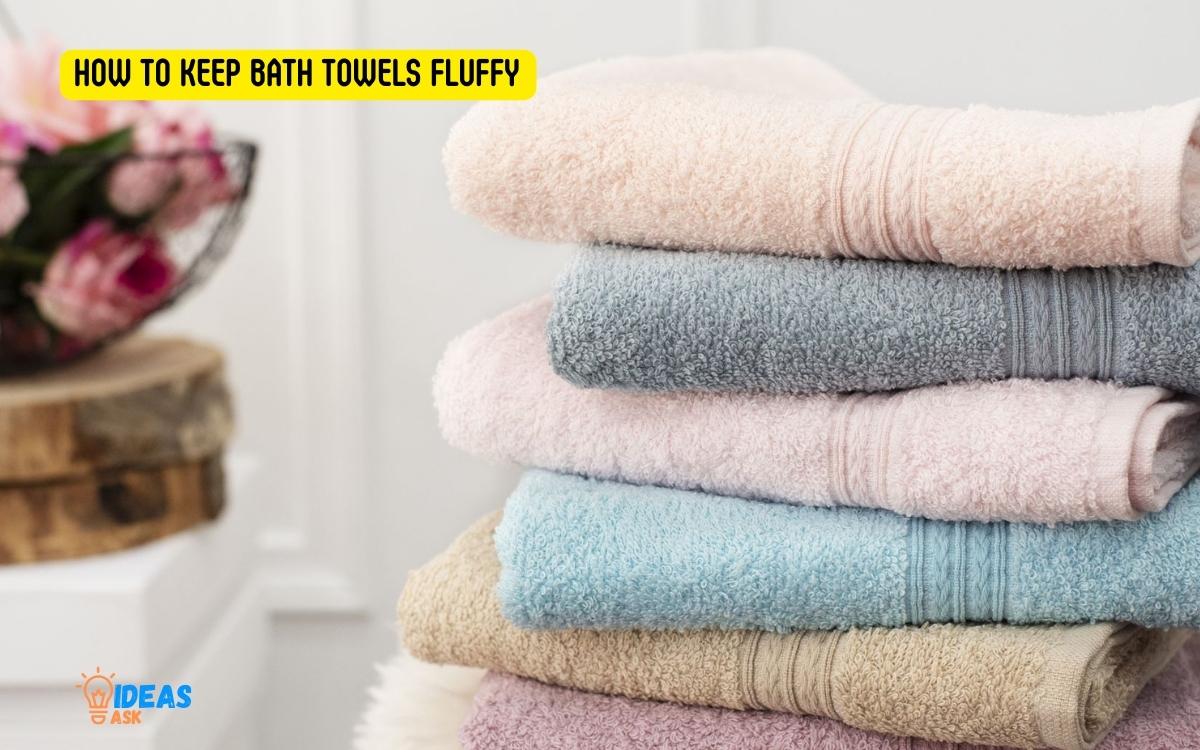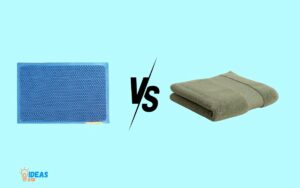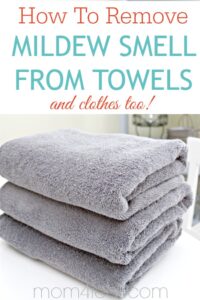How to Keep Bath Towels Fluffy? Discover!
To keep bath towels fluffy, you should wash them in warm water using a gentle laundry detergent.
Avoid using fabric softeners as they can decrease the towel’s absorbency. Instead, use white vinegar or baking soda during the wash cycle.
Lastly, dry your towels thoroughly in the tumble dryer or hang them to dry in the sun.
The reason for maintaining a regular wash routine for your bath towels is to remove the residue of dirt and oils that can accumulate over time. These residues can cause the fibers to clump together, making the towel feel less fluffy and absorbent.
The use of white vinegar or baking soda helps to strip away this residue without damaging the towel’s fibers. Drying your towels properly also helps to restore and maintain their fluffiness.
Maintaining the fluffiness of your bath towels doesn’t require a lot of effort. Simply follow a regular washing routine, avoid using fabric softeners, and ensure proper drying.

Key Takeaway
Why Do Towels Lose Their Fluffiness?
Towels lose their fluffiness over time due to repeated use and washing. To keep bath towels fluffy, avoid using too much detergent, use fabric softener sparingly, and try using dryer balls or tennis balls in the dryer to help fluff them up.
Fluffy bath towels are a luxurious addition to any bathroom, but over time, they can lose their softness and become less fluffy.
This can be quite frustrating, especially when you want to wrap yourself in a warm and cozy towel after a relaxing bath or shower.
So, why do towels lose their fluffiness? Let’s delve into some of the factors that contribute to this issue and explore how moisture, detergent, washing methods, and drying techniques can affect towel texture.
Factors That Contribute To Towel Loss Of Fluffiness:
- Frequent use: The more you use your towels, the more they are exposed to friction, which can break down the fibers and lead to a loss of fluffiness.
- Low-quality towels: Towels made from low-quality materials tend to lose their fluffiness more quickly compared to higher-quality towels. The quality of the fibers used determines how well the towel retains its plushness over time.
- Over-drying: Excessive drying can damage the fibers and make them stiff, resulting in a less fluffy texture. It’s important to find the right balance between drying your towels thoroughly and avoiding excessive heat or drying time.
- Improper storage: Folding wet or damp towels and leaving them in a crumpled heap can cause the fibers to become matted and compressed, reducing their fluffiness. Properly hanging or neatly folding towels after use can help maintain their fluffy texture.
How Moisture, Detergent, And Washing Methods Affect Towel Texture:
- Moisture level: Excess moisture in towels can weigh them down and flatten their fibers, resulting in reduced fluffiness. It’s essential to ensure that towels are adequately wrung out after use to avoid excessive moisture retention.
- Detergent choice: Harsh detergents and excessive use of fabric softeners can leave residue on towels, making them less absorbent and affecting their fluffiness. Opt for a mild detergent and use it sparingly to keep your towels in optimal condition.
- Washing methods: Aggressive washing methods such as vigorous rubbing or using high-speed spin cycles can cause damage to the fibers, leading to a loss of fluffiness. It’s best to wash towels on a gentle cycle with mild agitation to preserve their fluffy texture.
The Impact Of Drying Techniques On Towel Fluffiness:
- Air drying: Allowing towels to air dry naturally can help maintain their fluffiness as it eliminates the risk of heat damage. However, this method may take longer, especially in humid environments.
- Tumble drying: If using a dryer, select a low or medium heat setting to prevent excessive heat exposure. Adding a couple of dryer balls or clean tennis balls can aid fluffing by agitating the towels during the drying process.
- Avoiding dryer sheets: While dryer sheets may provide a pleasant scent, they can leave a residue on towels that hinders absorbency and reduces fluffiness. Consider skipping the use of dryer sheets when drying your towels.
By understanding these factors and implementing proper care techniques, you can help keep your bath towels fluffy, ensuring a delightful and cozy experience with each use. So, embrace the softness and fluffiness of your towels, and enjoy that luxurious feeling every time you wrap yourself up after a refreshing bath or shower.
Choosing The Right Towels For Fluffiness
To ensure fluffy bath towels, focus on proper care and maintenance. Regularly wash using gentle detergents, avoid fabric softeners, and tumble dry with dryer balls or tennis balls to maintain optimal fluffiness.
When it comes to keeping your bath towels fluffy, choosing the right towels is essential. Different towel materials, GSM (grams per square meter), and weaves can have a significant effect on the fluffiness of your towels. In this section, we will explore these factors in detail to help you make an informed decision.
Understanding Towel Materials And Their Effect On Fluffiness
To achieve a fluffy towel experience, it’s essential to understand how different materials perform in terms of fluffiness.
Here are some popular towel materials and their impact:
- Cotton towels: Cotton is a widely used material for towels due to its softness and absorbency. Towels made from 100% cotton or a cotton blend are known for their fluffiness. The long fibers in cotton help to create a plush and fluffy texture.
- Egyptian cotton towels: Egyptian cotton is known for its superior quality and luxurious feel. It has longer and finer fibers than regular cotton, resulting in exceptionally soft and fluffy towels.
- Microfiber towels: Microfiber towels are made from synthetic fibers that are incredibly fine and densely woven. While they may not offer the same level of fluffiness as cotton towels, they are highly absorbent and quick-drying.
Identifying Towels With Higher Gsm (Grams Per Square Meter)
GSM refers to the density and thickness of a towel, and it plays a crucial role in determining its fluffiness. Towels with a higher GSM are generally softer and more plush.
Here’s what to consider:
- Low GSM (300-400): Towels with a lower GSM may be thinner and less fluffy. They are lightweight and quick-drying, making them suitable for travel or gym use.
- Medium GSM (400-600): Towels with a medium GSM offer a balance between thickness and fluffiness. They are versatile and ideal for everyday use.
- High GSM (600+): Towels with a higher GSM are thick, plush, and extremely fluffy. They provide a luxurious spa-like experience but may take longer to dry.
Considering Towel Weaves For Enhanced Fluffiness
The weave of a towel also contributes to its fluffiness. Different weaves determine how the fibers are intertwined, affecting the overall texture and absorbency.
Here are some popular towel weaves:
- Terry cloth weave: Terry cloth is a common weave used in bath towels. It features loops of thread on both sides, providing excellent absorbency and a fluffy texture.
- Waffle weave: Waffle weave towels have a distinctive textured pattern that allows for better air circulation and faster drying. While they may not be as fluffy as terry cloth towels, they are lightweight and highly absorbent.
- Velour weave: Velour towels have a smooth and velvety surface on one side, creating a luxurious feel. While they may not be as fluffy as terry cloth towels, they are incredibly soft and gentle on the skin.
Selecting the right towels for fluffiness involves considering the material, GSM, and weave. Cotton towels, particularly those made from Egyptian cotton, are known for their plushness.
Additionally, towels with higher GSM provide a more luxurious feel, while different weaves offer varying levels of fluffiness and absorbency.
By understanding these factors and making an informed choice, you can ensure that your bath towels remain fluffy and cozy.
Wash Care Tips For Fluffier Towels
Discover the secrets to achieving fluffy bath towels with these simple wash care tips. Keep your towels soft and luxurious by avoiding the use of excessive detergent, using vinegar in the rinse cycle, and opting for a gentle drying method.
Fluffy towels can make a big difference in your bathing experience. There’s nothing quite like wrapping yourself in a plush, soft towel after a nice warm shower. But over time, towels can lose their fluffiness and become stiff and scratchy.
Don’t worry, though, we’ve got you covered! In this section, we’ll discuss some wash care tips that will help you maintain the fluffiness of your towels for longer. Read on to discover the secrets to fluffier towels.
The Ideal Washing Temperature For Maintaining Towel Fluffiness:
Use warm water
Washing your towels in warm water helps in maintaining their fluffiness. Aim for a temperature between 40°C and 60°C (104°F and 140°F) to ensure that the fibers stay soft and don’t get too rough.
Avoid using hot water as it can not only damage the texture of the towels but also wear them out faster.
Avoid cold water
While cold water may be suitable for some laundry items, it’s not ideal for keeping towels fluffy. Cold water can make it difficult for the detergent to dissolve, leaving behind residue on the towels and making them feel stiff.
Using The Right Amount Of Detergent And Avoiding Fabric Softeners:
Measure the detergent
Using too much detergent can leave residue on your towels, making them feel stiff. Measure the recommended amount of detergent based on the load size and follow the instructions on the product packaging.
Skip the fabric softener
Fabric softeners may make your towels smell nice and feel soft initially, but over time, they can create a build-up that reduces their fluffiness. Instead of fabric softener, opt for vinegar or baking soda as a natural alternative (more on that later).
Utilizing Vinegar Or Baking Soda For Towel Rejuvenation:
Vinegar benefits
Adding half a cup of white vinegar to your towel load during the rinse cycle can help restore their fluffiness.
The vinegar acts as a natural fabric softener, removing any residue left by detergent and restoring the fibers’ natural texture.
Baking soda benefits
Sprinkling half a cup of baking soda directly onto your towels before starting the wash cycle can also help revive their fluffiness.
Baking soda acts as a natural deodorizer and fabric softener, making your towels feel soft, fresh, and fluffy.
Implementing these wash care tips will help you maintain the fluffiness of your towels and ensure a luxurious bathing experience every time.
Remember to use warm water, measure your detergent, skip fabric softeners, and incorporate vinegar or baking soda as needed.
Say goodbye to scratchy towels and enjoy the ultimate coziness of fluffy, soft towels.
Drying Techniques For Fluffier Towels
Learn effective drying techniques to maintain the fluffiness of your bath towels. By following these tips, you can keep your towels soft, absorbent, and cozy after every wash.
The Importance Of Air Drying In Preserving Towel Fluffiness
Air drying is a crucial technique in maintaining the fluffiness of your bath towels. By allowing them to dry naturally, you minimize the risk of damaging the towel fibers and ultimately ensure their long-lasting softness.
Here are some points to keep in mind regarding the importance of air drying:
- Hang your towel up to dry on a clothesline or towel rack: Opt for air drying rather than relying solely on the dryer.
- Choose a well-ventilated area: Ensure that the towel is exposed to fresh airflow to aid in the drying process.
- Avoid direct sunlight: Sunlight can fade the color of your towels, so find a shaded area for air drying.
- Flip the towel over: Turn the towel halfway through the drying process to ensure even airflow and prevent one side from becoming damp.
Avoiding Excessive Heat And Over-Drying In The Dryer
When using a dryer to dry your towels, it’s crucial to avoid excessive heat and over-drying. High temperatures and prolonged drying times can cause damage to the fibers and lead to stiff and less fluffy towels.
Follow these tips to prevent over-drying:
- Opt for the low heat or delicate setting: Choose the appropriate heat setting on your dryer to keep the temperature gentle.
- Remove towels while slightly damp: Take out your towels from the dryer when they are slightly damp, as they will continue to dry naturally and maintain their fluffiness.
- Dry similar items together: Dry towels with other towels or similar fabrics to ensure even drying and prevent over-drying.
Tumble Drying With Dryer Balls Or Tennis Balls For Added Fluffiness
To enhance the fluffiness of your bath towels, consider using dryer balls or tennis balls in the tumble drying process.
These balls help to create separation between the fibers, preventing them from clumping together and resulting in a more fluffy texture.
Here’s how to use them effectively:
- Add dryer balls or tennis balls to the dryer: Place a few dryer balls or tennis balls into the dryer along with your towels.
- Let them bounce around: As the balls tumble, they will help to fluff up the towels and prevent them from becoming compacted.
- Use a low heat setting: Again, opt for a lower heat setting to prevent any potential damage while using the dryer balls.
By incorporating these drying techniques into your towel care routine, you can effectively maintain the fluffiness and softness of your bath towels for an extended period.
Enjoy the luxurious feeling of fluffy towels every time you step out of the shower!
Additional Tips For Maintaining Towel Fluffiness
To keep your bath towels fluffy, follow these additional maintenance tips: shake them out after each use to remove excess moisture, avoid using fabric softeners as they can reduce fluffiness, and give them a regular tumble dry on low heat to fluff them up.
Regularly fluffing towels by shaking them out:
- Give your towels a good shake after each use to help loosen any trapped fibers and restore their fluffiness.
- Hold one end of the towel and vigorously shake it a few times to loosen the compacted fibers.
- This simple action not only eliminates residual moisture but also helps re-fluff the fibers, ensuring your towels stay soft and fluffy for longer.
Gently pulling on the towel fibers to restore fluffiness:
- After washing your towels, they may lose some of their fluffiness due to the compression caused by water and detergent.
- Gently pull on the towel fibers in different directions to help release the compacted fibers and restore their volume.
- Be careful not to pull too hard or aggressively, as this may damage the fibers. A gentle tug is all it takes to loosen them up.
Storing towels properly to prevent compression and loss of fluffiness:
- Avoid overcrowding your linen closet or towel rack, as it can cause unnecessary compression and flatten your towels.
- Allow sufficient space between each towel to ensure proper airflow, which helps maintain their fluffiness.
- Avoid folding or stacking your towels too tightly, as this can lead to compression and loss of fluffiness.
- If possible, hang your towels on a towel bar to allow them to dry thoroughly to prevent dampness and mildew.
By following these additional tips, you can help keep your bath towels fluffy, soft, and absorbent, enhancing your bathing experience.
Remember to shake them out regularly, gently pull on the fibers, and store them properly to prevent compression and loss of fluffiness.
These simple steps ensure that your towels remain luxurious and cozy, providing you with the ultimate comfort every time you use them.
How to Keep Bath Towels Fresh?
Keeping bath towels fresh involves proper care and hygiene practices to prevent odors, bacteria, and mildew.
Here are some tips to help you keep your bath towels fresh:
Hang Towels to Dry:
- After each use, hang your towels to dry thoroughly. Ensure they have enough space for air circulation.
- Avoid leaving damp towels in a heap, as this promotes the growth of bacteria and mildew.
Wash Regularly:
- Wash your towels regularly to remove oils, dirt, and bacteria. How often depends on usage, but every 3-4 uses is a general guideline.
- Use a mild detergent, and avoid using too much, as residue can accumulate and make towels stiff over time.
Avoid Fabric Softeners:
Skip fabric softeners when washing towels, as they can leave a residue that reduces the towels’ absorbency.
Use Vinegar:
Add white vinegar to the rinse cycle when washing towels. This helps remove soap residue, prevents musty odors, and softens towels. About half a cup of vinegar should be sufficient.
Baking Soda Booster:
Occasionally, add baking soda to your towel wash to eliminate odors and brighten colors. This is particularly helpful if your towels have a musty smell.
Avoid Overloading the Washer:
Wash towels in smaller loads rather than cramming too many into one load. This allows them to agitate and rinse more effectively.
Proper Drying:
Dry towels completely in a well-ventilated area or in the dryer. Make sure they are fully dry before folding or putting them away to prevent mildew growth.
Rotate Towels:
Rotate the use of your towels. This prevents one or two towels from getting excessively worn or developing odors while others remain unused.
Sunlight Exposure:
If possible, expose your towels to sunlight. Sunlight has natural antibacterial properties and helps freshen up towels.
Keep Towels Separate:
Avoid mixing towels with clothes that produce a lot of lint. Towels can attract lint, making them less absorbent.
Replace Old Towels:
Over time, towels lose their absorbency and may develop a persistent odor. If despite proper care, your towels are still not fresh, it might be time to replace them.
Remember, consistent and proper care will keep your bath towels fresh, soft, and absorbent for a longer time.
How to Keep Bath Towels White?
Keeping bath towels white can be a challenge, especially with regular use and exposure to various substances.
Here are some tips to help you maintain the whiteness of your bath towels:
- Separate Towels from Colored Items: Wash white towels separately from colored items to prevent color bleeding onto the towels.
- Use White Vinegar: Add white vinegar to the rinse cycle. This can help remove detergent residue and prevent yellowing. Use about half a cup of white vinegar in the rinse water.
- Avoid Overusing Detergent: Using too much detergent can leave a residue on towels, making them look dingy. Follow the recommended amount on the detergent packaging.
- Bleach Carefully: Chlorine bleach can help whiten towels, but use it sparingly, as it can weaken fibers over time. Check the care label on your towels, and if bleach is safe, use it in moderation. Oxygen bleach is a gentler alternative.
- Sunlight Exposure: Hang your towels in the sun to dry. Sunlight has natural bleaching properties and can help keep your towels white. However, prolonged exposure to direct sunlight might weaken fibers, so be mindful.
- Avoid Fabric Softeners: Fabric softeners can leave a waxy residue on towels, reducing their absorbency and making them look less vibrant. Consider skipping fabric softener or using it sparingly.
- Hot Water Wash Occasionally: Washing towels in hot water occasionally can help remove bacteria and keep them fresh. However, frequent hot water washing may contribute to wear and tear, so balance it with cooler washes.
- Pre-treat Stains: Treat any stains promptly before washing. Use a stain remover or a mixture of baking soda and water for stubborn stains. Pre-treating can prevent stains from setting.
- Regular Cleaning of Washing Machine: Clean your washing machine regularly to prevent any buildup of detergent or fabric softener residue that might transfer onto your towels.
- Rotate Towels: Rotate your towel usage to ensure that all towels get used regularly. This helps prevent some towels from looking more worn than others.
Remember to always check the care labels on your towels for specific instructions, as some towels may have special care requirements.
Additionally, consistent and proper care can help extend the life of your towels and keep them looking fresh and white.
Conclusion
To maintain the fluffiness of your bath towels, remember to follow these simple tips. First, always wash your towels separately from other laundry, using a gentle cycle and a small amount of mild detergent. Avoid using fabric softeners as they can leave a residue that makes towels less absorbent.
Second, be sure to dry your towels completely, either in a dryer or outside in the sun. Tumble them on low heat or air dry them to avoid any damage or shrinkage.
Third, avoid using bleach and harsh chemicals on your towels, as they can break down the fibers and reduce their fluffiness over time. Lastly, give your towels a good shake or fluff them up after each wash to restore their loftiness.
By following these steps, you can keep your bath towels soft, absorbent, and delightfully fluffy for years to come.






